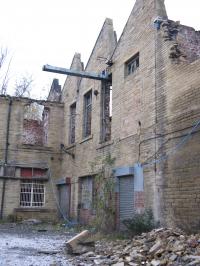Hick Well Mill
This was John Burnley's mill.
It was he who is said to have set up a rag machine in his barn in around 1813, worked by donkey power, and in competition with Benjamin Law's early experiments to produce shoddy. By the time Hick Lane mill was built the new product was clearly viable, and he was one of those originally involved there
Some time later John set up on his own at Hick Well nearby. This venture seems to have prospered in his time, and the firm is said to have been making druggets and pilot cloths, described as Batley's special line.
Although the Parliamentary Reform Act of 1832, in introducing a £10 property qualification, did little to satisfy the working classes, it did extent the male franchise to manufacturers such as John, and its passing is commemorated by the tablet now on the wall of the former lodge and mentioned on the blue plaque illustrated here.
The firm was clearly using shoddy, for when John died in 1836 in his will, seemingly envisaging sons Abraham, Samuel and Jacob carrying on the business, he specified that son John was to have the use of one rag machine and other equipment subject to an annual fee.
Willans tells us that somehow the sons did not do so well as their father, and by 1861 the mill was for sale.
It must have been then that it was bought by Sheards, who took on premises equipped for the full process of making cloth, with machines for scribbling and carding, spinning, weaving and finishing, not forgetting rooms for rag grinding. There seems to have been some rebuilding under the Sheard regime, and towards the end of their period of ownership the configuration of buildings was similar to that shown here, though the chimney was is a replacement of one formerly close to the turret of the central building, and the walkways may be a later addition.

It remained in their hands until the firm went into liquidation in 1907. It too was sold,and by the 1920s was in the occupation ofthe firm of James Hunt, importers and exporters of woollen and cotton rags. They too have gone, but some parts of the buildings remain in use, though sadly the farther substantial block in my illustration, and what were probably once weaving sheds beyond, have been destroyed in a recent fire.